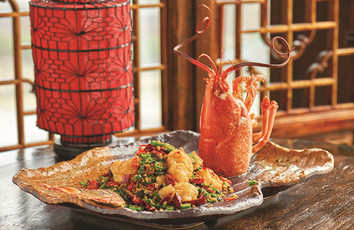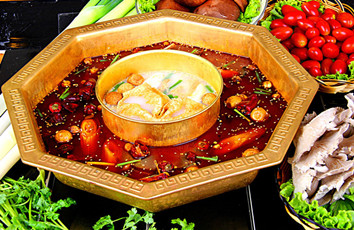川菜是如何征服全世界吃货的?
食在中国,味在四川。如果你在国外,看到路边一家家川菜馆子人流不息,千万不要感到惊讶。川菜作为中国最具代表性的菜系,越来越受到国外食客的欢迎。那么川菜是如何征服全世界的吃货的呢?我们来看看《南华早报》的分析文章。
Many may remember the 1998 film Mulan, the tale of a young Chinese girl who pretends to be a man to take her ailing father’s place in the army.
很多人还记得1998年上映的迪士尼动画电影《花木兰》。在这个故事中,一名中国少女扮作男子替代她年迈体弱的父亲从军。
In a joint promotion for the original animated feature, McDonald’s released a condiment called SzeChuan sauce for a limited time.
在配合这部原版动画片的联合推广活动中,麦当劳限时推出了一款名为“川酱”的调味酱。
Hong Kong-born Kevin Pang, who was raised in the United States, remembers it well from his teenage days.
香港出生、美国长大的凯文·庞(音)对这款自己少年时代的调味酱记忆深刻。
“It tasted very much like American Chinese food, it was too sweet. The texture was very gloopy, very sticky, and I think it was a little bit too out there for an American audience. If you eat chicken nuggets, you have barbecue sauce, you have hot mustard, but you don’t have this vaguely Asian style sauce. It was a novelty,” recalls Pang.
他回忆说:“那个酱尝起来非常像美国的中餐,太甜了。特别黏稠。我认为它有些过于适应美国人的口味了。吃鸡块的时候,会涂烧烤酱、芥末酱,但你不会涂抹这种亚洲风格的酱。这是一个新鲜事物。”

Interest in the sauce soon dissipated and it was forgotten until 2017, when an episode of cartoon show Rick and Morty - which featured a mad scientist and his adventures with his grandson - mentioned the SzeChuan sauce.
人们很快对这款调味酱失去了兴趣并将它遗忘。直到2017年,动画片《瑞克和莫蒂》的其中一集提到了这款川酱。这部动画片讲的是一位疯狂的科学家带着孙子探险的故事。
Fans of Rick and Morty began demanding the return of SzeChuan sauce, and a few months later, McDonald’s announced it would be revived - but for one day only - on October 7, 2017.
《瑞克和莫蒂》的粉丝们开始要求重新供应川酱。几个月后,麦当劳宣布将在2017年10月7日再次限时供应川酱——但仅此一天。

However, on the day, the fast-food chain was completely unprepared for the onslaught of people who turned up to get their hands on the sweet, Asian-style sauce.
然而,当这一天到来时,麦当劳对于前来索要这款亚洲风味甜酱的人潮毫无准备。
Each McDonald’s only had two dozen packs of the sauce to give away, and customers who had queued for hours were very angry, shouting: “We want sauce!” At one outlet in Newark, in the American state of New Jersey, the police had to be called in to calm things down.
每家麦当劳门店只准备了20多包川酱,这让那些排队数小时的顾客非常生气。他们高喊:“我们要川酱!”美国新泽西州纽瓦克的一家门店不得不通过报警来平息事态。
Sachets of the sauce have appeared on eBay selling for up to $250 each.
这种小包装酱料在易趣网上的标价一度达到每包250美元(约合1720元人民币)。
However, the sauce created by McDonald’s lacks any authentic Sichuan flavor. Sadly for fans of the too-sweet McDonald’s sauce, there is no such thing as a generic “Sichuan sauce” in the Chinese province, says cook and food writer Fuchsia Dunlop.
然而,这款由麦当劳开发的酱料根本不是正宗的四川风味。英国厨师兼美食作家邓扶霞说,在中国四川省根本没有通称“川酱”的东西,这对麦当劳这款甜酱的粉丝们来说非常遗憾。
“A really good Sichuan meal is like a roller-coaster ride - you have spicy notes, sweet and sour notes, numbing and gentle flavors,” says the British cook who has been researching Chinese cuisine for 25 years. That’s a far cry from what McDonald’s was trying to emulate.
这位研究中国烹饪长达25年的英国厨师说:“一顿地道的川菜大餐就像是过山车——有辣,有酸甜,有麻,也有柔和的口感。”这与麦当劳试图模仿的东西大相径庭。
Sichuan cuisine is one of the eight great cuisines of China and is famous for its fiery dishes. But Dunlop says it’s a common misconception that the cuisine focuses only on heat.
川菜是中国八大菜系之一,以火辣著称。但邓扶霞说,认为川菜只专注于火辣是一种常见的误解。

“There’s the stereotype that it is all just fiery and hot, and of course Sichuanese love using chillies and Sichuan pepper (hua jiao) - with its lip tingling sensation - but that’s just one part of the story. Sichuan is about complex multilayered flavors,” she says.
她说:“有人认为川菜只有火辣,这是一种刻板印象。当然,四川人喜欢使用辣椒和花椒——让你的唇齿发麻——但这只是一个方面。川菜有复杂的、多层次的味道。”
“The really interesting thing about Sichuan cuisine is its diversity of flavors. When I was studying to be a chef there, we learned 23 complex flavors. It is like French classic sauces, but with different balances of sweet, sour, spicy and tingly,” she says.
她说:“川菜真正有趣的地方在于它有多种味道。我在那里学习厨艺的时候,我们学到了23种复杂的味道。这就像法国的经典酱汁,只是甜、酸、辣、麻的比例各不相同。”
“Sichuan pepper is what makes Sichuan cuisine different from other spicy cuisines like Hunan, where they use a lot of chilli but don’t use [the numbing Sichuan pepper],” says Dunlop.
邓扶霞说:“花椒使川菜不同于其他以辣为特色的地方菜。比如,湘菜也使用大量辣椒,但不使用让舌头发麻的花椒。”
While Sichuan is one of the most popular regional cuisines in China, it only really caught on in the West 20 years ago, says Dunlop. “From the 1990s Sichuan food took off - you had all these people from all over China going to live in America and England and they wanted to eat their favorite food, which was Sichuan food.”
她说,尽管川菜是中国最受欢迎的地方菜系之一,但直到20年前,川菜才真正开始在西方流行起来。“从上世纪90年代起,四川美食开始受到欢迎——中国各地的人开始到美国和英国等地生活,他们希望吃到自己最喜欢的食品,也就是四川美食。”
Currently Sichuan hotpot is a hugely popular dish in China and the West, but Dunlop says dishes such as mapo tofu, gong bao chicken, and hui guo rou (twice-cooked pork) are all famous and express the techniques and flavors of Sichuan cooking.
目前,四川火锅在中国和西方都大受欢迎,但邓扶霞说,像麻婆豆腐、宫保鸡丁和回锅肉这样的菜肴同样有名,并且展现了川菜的烹饪技巧和味道。
In Hong Kong, a cultural and culinary crossroads of the East and West, chef Kenny Chan Kai-tak, 65, is keen on passing down how to cook Sichuan cuisine. The executive chef at Sichuan Lab in Wan Chai was born in Hong Kong to a family of chefs originally from Sichuan.
在香港这个东西方文化和饮食的交汇之地,65岁的厨师陈启德(音)热衷于传承川菜的做法。
He finds the fiery cuisine more difficult to learn how to cook because of the various combinations of chillies that can be used to elicit layers of spice.
他发现,辣味菜肴的烹饪更难学习,因为这些菜肴将各种辣椒进行不同的组合以产生多层次的味道。
“Sichuan cuisine allows your taste buds and the tip of your tongue to feel a ‘dancing sensation’. But not all Sichuan food is spicy - it can have surprisingly different kinds of spice, some that are mild, some that are extra hot, and their aroma can change depending on if they are cooked with meat or seafood. A spice that seems to be light in taste can have a very long, but strong aftertaste that hits you hard,” Chan says.
陈启德说:“川菜让你的味蕾和舌尖产生‘跳舞的感觉’。但不是所有的川菜都是辛辣的——它的味道多得惊人,有些是微辣,有些是超级辣,其味道会根据你是做肉菜还是海鲜而产生变化。有的调料看似口味清淡,但强烈的余味会给你带来回味长久且巨大的冲击。”
“Only one-third of Sichuan cuisine has spiciness in it. The reason why Sichuan food has varying levels of spice is because the province’s food is a mix of culinary styles, as immigrants from neighboring provinces brought different eating habits and cultures,” Chan says.
他还说:“只有三分之一的川菜是辣的。川菜之所以有各种各样的味道,是因为周边省份的移民带来了不同的饮食习惯和文化,因此它是不同地区烹饪风格的混合物。”


